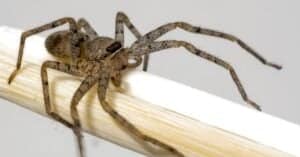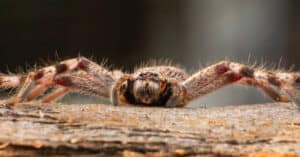“Spider!” is a commonly yelled phrase in homes and outdoors around the world. Many people are afraid of spiders – particularly large spiders or ones that can leap. Jumping spiders are amazing animals. They’re smart, have excellent vision, and are even considered cute in appearance.
About 6000 species of spiders that jump have been described worldwide, more than any other spider type. These spiders are found pretty much everywhere except Antarctica. Different species can live in tropical rainforests, scrublands, deserts, temperate forests, etc. Jumping spiders, like most other spiders, are venomous and have fangs. However, a bite will prove not harmful to humans, as the venom is too weak to affect us.
Check out some of the most amazing facts about these spiders below!
#1 Jumping Ability – 10-50x their body length!
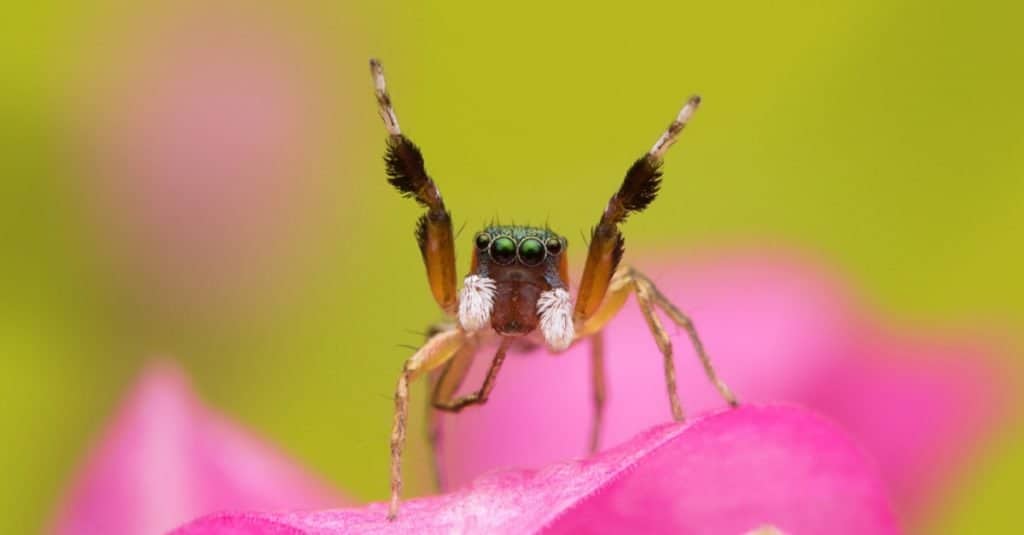
©Joyce LCY/Shutterstock.com
Most humans can only jump a few feet, much less than their length or height. Imagine being able to jump 10 times your height – you could leap tall buildings in a single bound!
Jumping spiders can do just that. A 1/2 inch spider could therefore jump 25 inches or more than two feet (most jumping spiders are between 0.1 and 2.5 cm in length – one inch or less)! How do these spiders jump so far?
Jumping spiders can be helpful to many different environments because they prey on other insects. While they can bite people, the jumping spider is not venomous or poisonous. If they feel threatened, they will flee rather than fight. Their rapid movements and can jump can be alarming but they can’t lethally harm you.
They increase the blood pressure in two or four of their back legs, which expands the legs to give their leaps a boost.
Jumping spiders are able to employ bimodal breathing – taking in oxygen via arachnid book lungs and a tracheal system. They also spin a single thread to stabilize the jump.
#2 Jumping Spiders Are Actually Cute
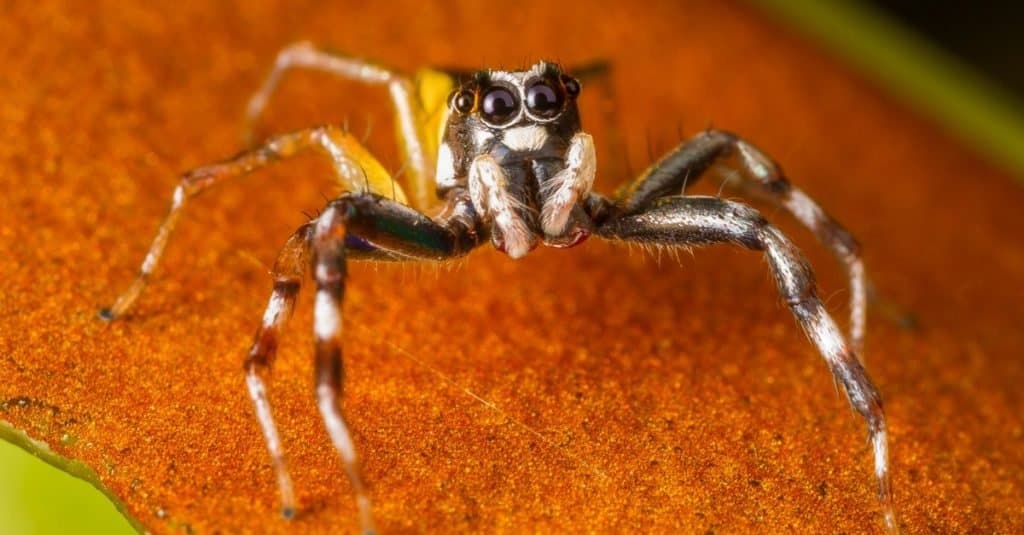
©kajornyot wildlife photography/Shutterstock.com
Some people may feel that the words “cute” and “spider” do not belong in the same sentence, but they obviously haven’t seen a jumping spider up close.
Jumping spiders have a particular arrangement of eyes – two very large forward-facing eyes with a smaller eye on each side. Just as large eyes make kawaii anime characters look cute and childlike, so do the large eyes of this spider.
Jumping spiders are also furry, and they often sport bright colors and bold patterns. Finally, their movements may resemble a dance as they “nibble” with their pedipalps – leglike appendages of the mouth – or wave their front legs in a defensive posture or mating dance.
#3 Jumping Spiders Literally Have Eyes on the Back of Their Heads
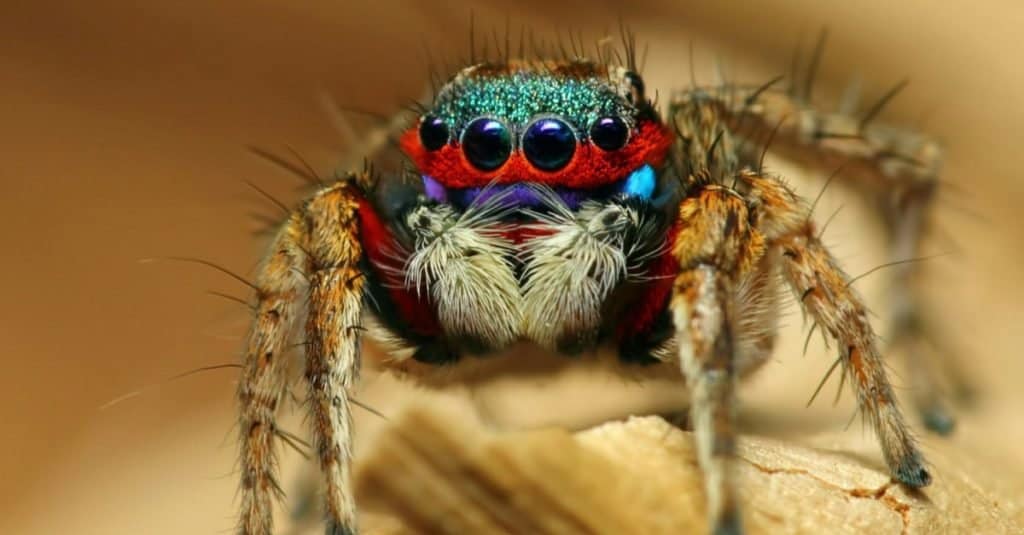
©Professional Fine Art/Shutterstock.com
In addition to the four large, cute eyes, spiders that jump have two more sets of eyes on the carapace for a total of eight eyes. The arrangement of eyes means the spider has virtually no blind spots in its vision. It can thus react quickly to danger or prey.
It can navigate from place to place by sight. A jumping spider’s visual field extends for about a foot, a huge distance for such a small animal. Its incredible eyesight also makes jumping spiders difficult to kill or catch.
#4 Jumping Spiders Are Really Smart
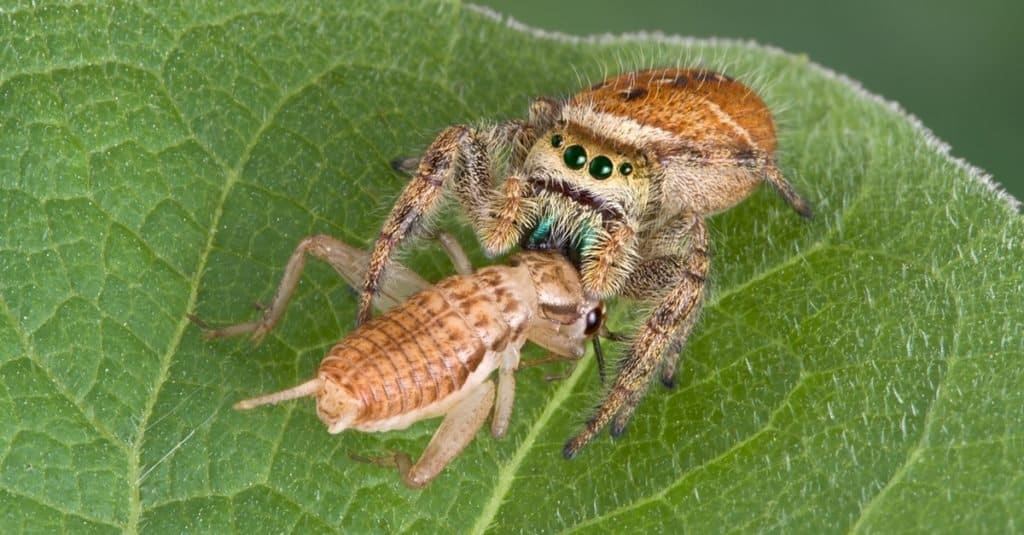
©Cathy Keifer/Shutterstock.com
Though their brains are tiny, scientists have proven that jumping spiders are especially smart and have the ability to learn. Here are a few examples:
- Many jumping spider species plan specialized routes to reach their prey rather than just rushing in on it. This quality is usually only observed in larger predators. They can even visualize where hidden prey might be hiding and find them.
- Jumping spiders belonging to the subfamily Spartaeinae act out elaborate dances to attract a mate. Usually, animals that small don’t have the visual acuity to utilize such a technique. The Australian peacock jumping spider is the size of a grain of rice. It has a colorful fan on its back which it expands and dances with. It may dance for almost an hour, but if the female doesn’t like the dance, she eats the male spider!
- Scientists in New Zealand developed an obstacle course, which jumping spiders navigated successfully. The maze consisted of towers, platforms, moats (jumping spiders don’t like to get wet), and containers of food. Their ability to plan and adapt when plans must change is called “genuine cognition.” It means they think before they act.
- Jumping spiders have good memories. In the above study, spiders sought out the container which had had food in it, even after researchers had replaced it with an empty container.
- Jumping spiders display site fidelity, meaning that if they find a good place to hunt or nest, they will return there if displaced.
#5 People Keep Jumping Spiders as Pets!
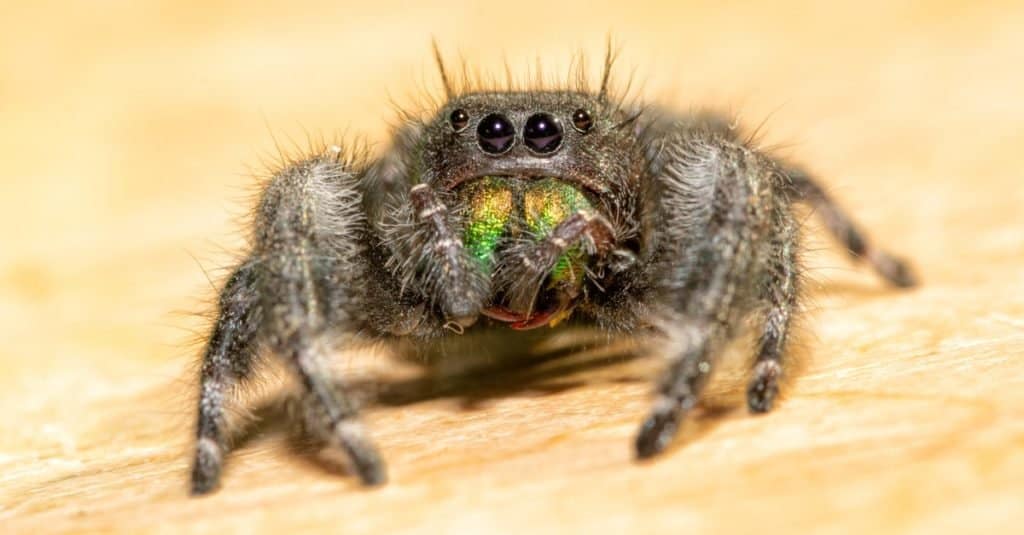
©Sari ONeal/Shutterstock.com
The following jumping spider varieties are sometimes kept as pets:
- The bold or daring jumping spider (Phidippus Audax) is larger than many other jumping spider species – about the size of one segment of your finger. It is black with white markings and metallic green or blue fangs. As its name suggests, it is not as shy as many of its cousins. It is native to North America.
- The regal jumping spider (Phidippus regius) is another North American native. This large jumping spider spins a nest of silk to sleep in.
- The tan jumping spider (Platycruptus undatus) lives under tree bark in the United States and Canada. Though they blend in well with their habitat, enthusiasts may scoop up this curious spider and carry it in their hand.
- The zebra jumping spider (Salticus scenicus) can be found throughout North America and Europe. Its name is derived from distinctive cream and black stripes.
- The elegant golden jumping spider (Chrysilla lauta) may be one of the most colorful invertebrates. It lives in the rainforests of Asia and has irredescent coloring in shades of gold, red, blue, pink, and green. This spider could easily be mistaken for a piece of jewelry!
Pet jumping spiders are generally not purchased at a pet store but are caught outdoors in nature. Some sources say the spiders adapt readily to a lidded aquarium with at least a cubic foot of space and plenty of twigs, rocks, and plants to hide in. What do people do with a pet jumping spider? They allow them to crawl on their hands, feed them live insects, and make social media videos of their antics.
Summary Of 5 Facts About Jumping Spiders
| Rank | Fact |
|---|---|
| 1 | Jumping spiders can jump 10-50x the length of their body. |
| 2 | Jumping spiders are cute. |
| 3 | Jumping spiders have eyes on the back of their head. |
| 4 | Jumping spiders are smart. |
| 5 | People keep jumping spiders as pets. |
Up Next…
We see spiders almost every day, yet what do we really know about them? Take a look at these articles for more information on spider species and facts about them!
- The World’s Most Venomous Spider – While this spider is pretty secluded to one area of the world, it is still important to watch out for it!
- Black Widow Spider – Spiders of almost folklore, the elusive black widow is quite an interesting spider.
- Baby Wolf Spider: Facts & Unbelievable Pictures! – Wolf spiders are common throughout the world.
The photo featured at the top of this post is © Tran The Ngoc/Shutterstock.com
FAQs (Frequently Asked Questions)
Are Jumping Spiders Dangerous to Humans?
Jumping spiders are not generally dangerous to humans. Jumping spiders are small, and many bite attempts don’t even break the skin. The University of California Davis reports that jumping spider bites are usually less painful than a bee sting and result in a welt similar to that caused by a mosquito bite.
They will not seek you out to bite you – these spiders only bite if they feel threatened, for instance, if you try to squish one with your hand.
Are Jumping Spiders Friendly?
Many people would describe jumping spiders as friendly. Their large eyes, the movements of their front legs and pedipalps, and tendency to “dance” make this type of spider the cutest of the arachnids. They also appear cautiously curious, often carefully observing nearby humans before retreating into a hiding place.
These spiders are not aggressive to humans unless they feel that their life is in danger. They tend to shy away from direct contact. Their venom is weak and their small fangs may fail to break the skin. The spiders will bite, however, if you squeeze, trap, or crush them.
Why Do Jumping Spiders Jump at You?
Jumping spiders do not jump at you in order to bite you. They may see you as a threat or a predator and try to jump to escape. In escaping your face, they may accidentally land on your leg, arm, etc.
Alternatively, something may have caught the spider’s interest. It might jump on you to get closer to a potential prey item or you may simply be a “bridge” it is using to get from one place to another. This is especially the case if you’ve placed yourself between the spider and its nest – it is likely just trying to get home.
Can a Jumping Spider Kill You?
Jumping spider venom is typically less severe than an average bee sting. However, people with allergies to arthropod venom should seek medical help if bitten. Without treatment, an anaphylactic allergic reaction could result in death.
Where Do Jumping Spiders Live?
Three hundred species of jumping spiders are native to the United States, and about 6000 species can be found around the world. They live in Europe, North and South America, Asia, and Australia.
Thank you for reading! Have some feedback for us? Contact the AZ Animals editorial team.




